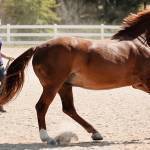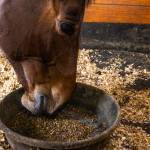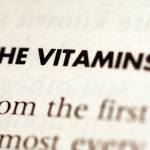Question
What combination of feeds provides a balanced diet, maintains body condition, and reduces the likelihood of colic?
Answer
Without knowing exactly what kind of horse you own, it is difficult to make specific feeding recommendations.
Most horses should consume forages as their primary source of calories. The most common forages include pasture grasses, long-stem hay, hay cubes, and hay pellets. High-quality forage should be fed, though depending on the horse, mid-quality forage might be acceptable. Dusty or moldy hay should not be fed to horses, and any hay with an off-putting odor should be discarded, too. A near-continuous supply of forage is best, and this allows horses to choose when to eat, which is the most natural of feeding situations. Because they are grazing animals, horses depend on a steady intake of forage for optimal health of the gastrointestinal tract.
Maximizing the amount of forage fed in the diet can reduce the risk of colic. Horses should consume about 1.5-2% of their body weight in forage per day; therefore, a 1,000-lb (450-kg) horse would eat about 15-20 lb (7-9 kg) per day to maintain body condition. This is a guideline, and certain horses will require more to maintain a healthy weight.
In addition to hay, a source of vitamins and minerals should be offered. More often than not, this is achieved through the use of a textured or pelleted concentrate. Some horses need the addition of concentrates to meet their energy requirement. When formulated by a reputable manufacturer, these concentrates have the nutrients necessary for the given stage of life, so long as they are fed at the recommended amounts. Feeding a quality concentrate and making any changes in type or amount gradually can reduce colic risk. If the manufacturer’s recommendations provide too many calories (and a horse becomes too fat), a ration balancer or a well-formulated vitamin and mineral supplement should be offered instead.
Horses should always have access to free-choice salt and fresh, clean water. The water source should be checked daily.
Avoiding colic is not always possible, but following the aforementioned guidelines is an appropriate leaping-off point.
These are the most basic of feeding recommendations. If you’d like a thorough review of your horse’s diet, please complete a description of your horse(opens new window).








